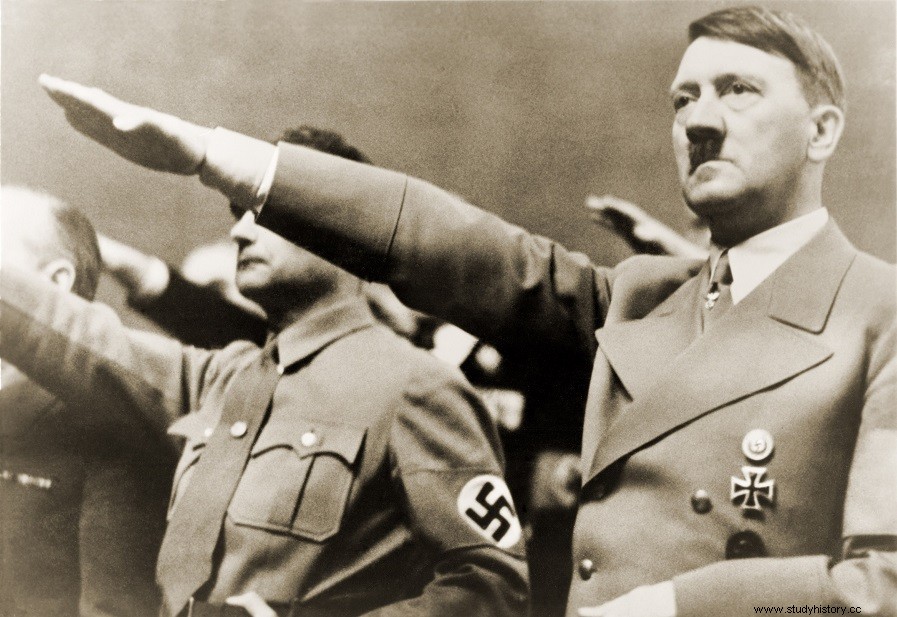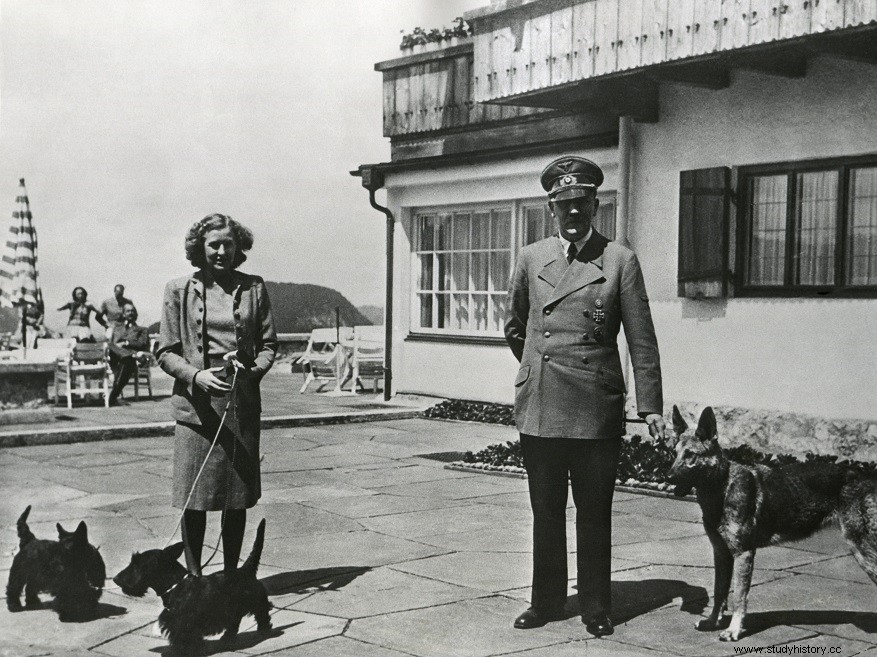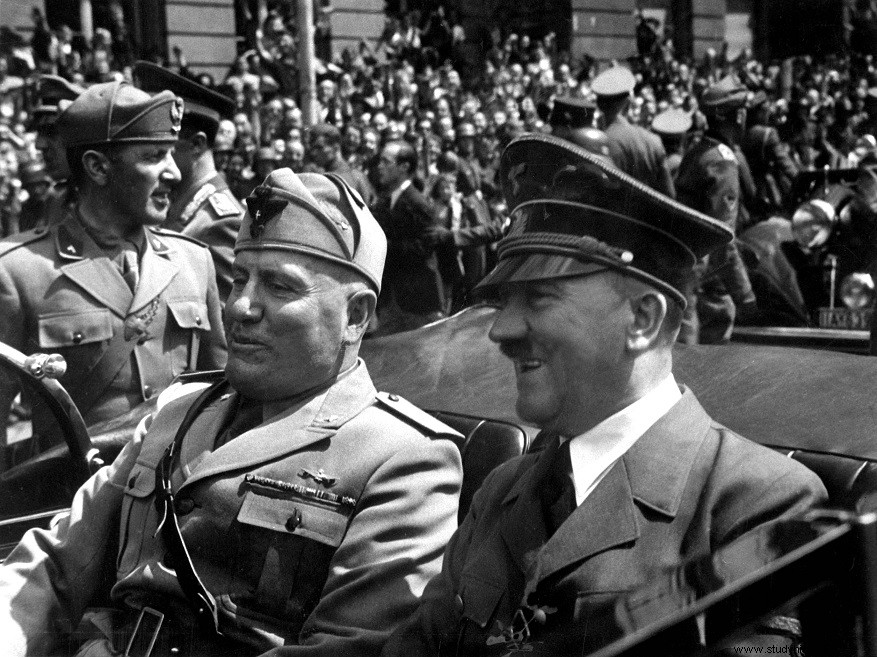
Who was Adolf Hitler?
Adolf Hitler he is one of the greats of the 20th century, just as he is one of the greats of history. Hitler's name, however, was not known for positive deeds, but for the fact that the Austrian led a tyrannical regime that plunged Germany into hatred and was responsible for mobilizing a country against a people. Hitler's actions as leader of Nazism and ruler of Germany led the world into World War II and the greatest genocide in history:the Holocaust.
Hitler's Birth and Youth
Adolf Hitler was born in Braunau am Inn, Austria, on April 20, 1889. Hitler was the fourth child of Alois Hitler and Klara Pölzl and the first to survive childhood (the other three had died as children). His father was a respected civil servant who worked at a customs post. Because of this, Hitler belonged to a middle-class family, which had a very healthy financial condition.
Historians always report the difficulty of obtaining accurate information related to Hitler's childhood precisely because of the difficulty of confirming the veracity of the information. Furthermore, historians regard Hitler's accounts of his own childhood with considerable suspicion.
Anyway, Hitler's parents died while he was in his teens. Hitler's father, Alois, died on January 3, 1903, after a sudden illness, and his mother died of cancer on December 21, 1907. Hitler's biographers say that he showed affection in life only towards his mother. .
The father's death put an end to a troubled part of Hitler's childhood and adolescence, as the father wanted his son to follow his own example, becoming a civil servant, a respected craft. and with a good salary at the time. Hitler, in turn, wanted to be an artist. Differences between father and son turned into constant bickering.
With the death of his father, Hitler abandoned his studies and moved to Vienna, the capital of Austria. There in Vienna, Hitler tried to enter the city's Academy of Fine Arts, but twice had his applications rejected. After that, Hitler followed the life of an idler, as he did not work and did not make a point of finding a job. He lived off a loan he got from his aunt, the pension he received after his mother's death, and the inheritance he received.
Hitler in World War I
In 1913, Hitler moved from Vienna to Munich, and the following year, with the outbreak of World War I, he volunteered for the German Army. Hitler's departure for Germany took place after receiving his inheritance from his father, a total amount of 819 crowns |1| (a considerable sum at the time), and also because he was fleeing the Austrian military draft.
In the German army, Hitler assumed the post of messenger and had an outstanding performance, receiving two important decorations in the German army. As far as the patent is concerned, Hitler never surpassed the patent of cable , the highest allowed for a foreigner in the German army at that time (remember:Hitler was Austrian).
Hitler's association with far-right movements in Germany was consolidated after the defeat of the Germans in the First World War. Hitler was in the infirmary (victim of a mustard gas attack) when the Germans signed the surrender with the French and British. He never accepted the defeat the Germans suffered and adhered to conspiracy theories.
One of the conspiracy theories that Hitler adhered to and that was very strong in Post-World War I Germany was the “theory of stab in the back ”. This theory claimed that Germany's defeat had been part of a conspiracy by socialists and Jews to sabotage Germany in the war. This conspiracy theory was exploited by far-right movements, including Nazism.
Also see: Christmas Truce in World War I
Hitler's political trajectory
Hitler's political career growth was directly related to events in post-World War I Germany. The country emerged from the First World War defeated and humiliated by its adversaries. Germany's exit from the conflict resulted from an internal revolution that overthrew the German monarchy and established a liberal republic.
This German republic became known as Weimar Republic and was ruled by the Social Democrats, a center-left party in Germany. This first democratic experiment in Germany was extremely troubled because of the effects of the war. To begin with, there was the aforementioned feeling of “betrayal” regarding the surrender of the country led by the Social Democrats.
After the war, the humiliation that the country suffered with the Treaty of Versailles generated strong resentment in German society. Furthermore, the effect of the war on Germany's economy was devastating and dragged the country into the biggest economic crisis in its history. Against this backdrop of resentment towards the Social Democrats and the victors of the war and despair over the economic crisis, Hitler's speech prospered.
From 1919, Hitler joined the German Workers' Party , a conservative party that had nationalist, anti-Semitic, and anti-Marxist rhetoric. Over time, Hitler's influence within the party grew, and the party changed its name to National Socialist German Workers' Party .
At that time, Hitler's influence was still limited (so much so that it was not until 1921 that Hitler became party leader). In any case, the initial program of the Nazi Party was written by Anton Drexler (the party's first leader) and by Hitler. Historian Ian Kershaw stated that the party's initial program had the following proposals:
[…] demand for a Greater Germany, [with more] lands and colonies, discrimination against Jews and denial of citizenship to them, breaking of “slavery of interest”, confiscation of war profits, land reform, protection of the middle class, persecution of speculators and strict regulation of the press […]|1| .
It was at this time that Hitler discovered his great talent:oratory . The ability to speak in front of crowds was what ensured his success, as well as the success of the party. The persuasiveness of Hitler's speech was so great that in about a year and a half the party increased its membership from 190 to 3300 |2| . It was his role in the growth of the party that made him reach the leadership in 1921.
In 1923, Hitler coordinated a coup attempt in Bavaria, the southern German state that was the birthplace of far-right conservative movements in the country. This attempted coup is known as “Putsch from the Brewery ” and failed when Hitler's party forces were dispersed by Bavarian government forces. Hitler was arrested and ended up spending a year in prison.
It was in jail that Hitler wrote the book that became the ideological guide to Nazism, Mein Kampf (My Struggle, in Portuguese). Despite this, statements against Jews and against Marxism had already been recorded at another time. The first anti-Semitic statement by Hitler that historians have record is from 1919 and the first anti-Marxist statement is from 1920.
Also see: Meet the political party that inspired the Nazi Brewery Putsch
Rise to Power
After leaving prison in 1925, Hitler began work on rebuilding the Nazi Party. Despite his radical speech, he acted to achieve power in Germany through democratic means. From that moment on, Nazism took a series of actions to increase its influence over the population and attract members.
Historian Lionel Richard, for example, says that the Nazis created a series of associations to attract people. According to Lionel Richard:
Little by little, the Nazis strive to attract the population through a network of organizations specifically aimed at each social category. In July 1926, the Hitler Youth was born. Six months later, an Association of National Socialist Students appears in the universities. In 1928, a league was created to fight for German culture, destined to the artistic professions and under the direction of Alfred Rosenberg. Next, leagues of doctors, jurists, professors and Nazi students emerge. For women, the Women's Order of the Red Gamada Cross brings together the associations animated by Elsbeth Zander, promoted to head of women's affairs at the direction of the Nazi Party. From 1927, a union policy aimed at workers was launched, with little success, through the Organization of Cells of the Company |3| .
Through measures like this and, again, from his populist speech, which promised a strong Germany again and created scapegoats as the great responsible for all the evils in Germany, Hitler was quite successful. After securing German citizenship in 1932, he ran in the country's presidential elections.
In this election, Hitler ran directly against Paul von Hindenburg , a German military man well known for leading German troops during World War I. Despite being defeated in the presidential race, Hitler came out strengthened, as he managed to secure himself as one of the great names of German politics.
In the aforementioned election, in the second round, Hitler got almost 37% of the votes, and Hindenburg, the winner, had 53%. Despite the defeat, a short time later (in 1933), Hitler ascended to the power of Germany as chancellor because of the crisis in which the country found itself and the great pressure exerted on Hindenburg to appoint Hitler German Chancellor.
Hitler in power

Hitler married Eva Braun the day before he committed suicide.*
Once in power, Hitler began to take measures to prevent the strengthening of a democratic coalition against the Nazi Party and began the persecution of his opponents. Along with Hitler, the Nazis held two other important positions in the German government:Wilhelm Frick was appointed to the Ministry of the Interior and Hermann Göring was appointed to the Prussian Ministry of the Interior.
With power in hand, Hitler silenced his opponents. Communists and Social Democrats began to be arrested en masse and many were sent to camps from concentration . The first concentration camp created by the Nazis was that of Dachau , in 1933, which received communists and social democrats.
An event that marked the Nazis' authoritarian turn in Germany's power was the fire of Reichstag (German Parliament), in February 1933. Historians such as Ian Kershaw and Richard J. Evans point out that the person responsible for the fire was Marinus van der Lubbe , a Dutch communist who decided to act on his own (since he had no ties to any communist and socialist parties in Germany). Some historians, however, point out that the fire of the Reichstag it was caused by the Nazis themselves in a false flag operation.
From 1934 onwards, Hitler began to consolidate his dictatorship over Germany. Political parties (including those on the right) began to be persecuted. The Nazi Party remained the only one functioning in Germany. Also, that year, Hindenburg died, which gave Hitler the powers of president and chancellor.
From there, Hitler took steps to recover the German economy, and this was done at the expense of the purges carried out against Jews. Thousands of Jewish families began to have their assets seized by the German government, which also encouraged the printing of paper money and promoted public works to employ the mass of unemployed.
Hitler also began to take action against what had been agreed in the Treaty of Versailles. Germany has gone through a process of remilitarization gigantic, its army was reformulated and exceeded the maximum number of 100 thousand soldiers stipulated by the Treaty of Versailles. A navy and warplanes were created, and the Rhineland was remilitarized. Hitler also ordered an end to the payment of the treaty indemnity.
Next, Hitler intensified his violence against Jews, creating discriminatory laws that reduced the civil rights of this community and made it the target of constant violence by troops in the service of Nazism (the SS and SA). As far as foreign policy is concerned, from 1938 onwards, Hitler began to take measures for the constitution of the Lebensraum (the “living space” of the Aryans).
This “living space” was part of the Nazi ideology and basically consisted of a land that would be the “right” of the Germans (Aryans). It would be the minimum space necessary to constitute a prosperous Third Reich (empire), in which the Aryans would live at the expense of the exploitation of the Slavs' work. Hitler's ambition turned to Austria and Czechoslovakia (annexed in 1938 and 1939). Hitler's last move was against Poland .
The invasion of Poland ended up yielding the beginning of the Second World War, as the British and French had accepted the invasion of Austria and Czechoslovakia, but were adamant about not accepting the invasion of Poland. Poland. The invasion of Poland took place on September 1, 1939 and marked the beginning of World War II.
World War II

Benito Mussolini's Italy was Germany's biggest partner during World War II.*
During World War II, Hitler commanded German troops. Germany's participation in World War II was marked by two distinct moments:a period of rapid advances, which took place from 1939 to 1941, and another of gradual defeat for the Allies, which began in 1942 and ended in 1945.
Throughout the Second World War, historians point to several decisions made by Hitler that were crucial to the German defeat. Chief among them was the invasion of the Soviet Union in 1941. Hitler knew that Germany did not have the resources for a prolonged conflict with the Soviets. His insistence cost him the war and his life.
With his forces on the brink of defeat and Soviet troops inside Berlin, Hitler married Eva Braun and chose to commit suicide so he wouldn't be captured by his enemies. In his underground shelter, committed suicide on April 30, 1945, shooting himself in the head. After committing suicide, his body was cremated by Nazi soldiers.
Also see: Discover the history of the last Nazi offensive in World War II
Holocaust
Hitler's hatred of Jews was something he carried from his youth. Historians debate the time in his life when Hitler adopted this gigantic hatred of Jews, and most historians believe it happened during the time he lived in Vienna. Upon taking power from Germany, Hitler took action against the Jews in Germany.
The result of Hitler's cultivated anti-Semitism throughout Germany resulted in the Holocaust . The Nazis debated ways to deal with the “Jewish question”, and the Holocaust took place at different stages. First the Nazis imprisoned Jews in ghettos and concentration camps. They also discussed ways of dealing with Jews, expelling them to places like Madagascar.
Nazi anti-Semitism turned into genocide when Hitler ordered the execution of Jews in Europe in 1941. The first phase of the Holocaust took place with the mass shootings promoted by death squads (Einsatzgruppen). Then, the use of extermination camps was adopted for the execution of Jews in gas chambers . The result of the Holocaust was the death of six million Jews .
|1| KERSHAW, Ian. Hitler. São Paulo:Companhia das Letras, 2010, p. 119.
|2| Ditto, p. 123.
|3| RICHARD, Lionel. The Weimar Republic 1919-1933. São Paulo:Companhia das Letras, 1988, p. 127-128.
*All image credits:Everett Historical and Shutterstock
Take the opportunity to check out our video lessons related to the subject:
